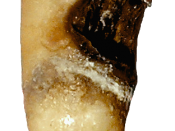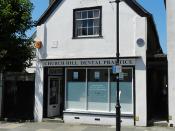Plaque is a thin sticky, colorless film that is constantly forming on our teeth. Plaque is the bi-product of the bacteria and food particles that are in the mouth. A few hours after eating plaque will begin to form on the teeth. If plaque is allowed to remain on the teeth, minerals in the saliva will combine with the dental plaque and form a hard deposit called calculus.
Tooth decay is the disease also known as cavities or caries. Tooth decay is the result of the reaction between dental plaque and the deposits left on the teeth from foods high in sugars, most commonly glucose, sucrose and lactose, and bacteria. The two bacteria that are most closely linked to the formation of decay are Streptococcus mutans, which feed on the sugars in foods, and lactobacilli, which plays a lesser roll in the formation of cavities in the pit and fissure areas of the tooth.
These bacteria digest the sugars left in the mouth and produce lactic acid. Over a period of time lactic acid will erode or dissolve the enamel of the tooth causing small defects, which will eventually become a cavity.
It is generally accepted that bacterial plaque is the primary cause of gingivitis and periodontitis. Periodontal disease is the most common infection in the United States. Seventy five percent of adults over the age of thirty-five have some form of periodontal disease. There are 10-20 bacterial species frequently associated with the presence of periodontal disease. The most common bacteria associated with periodontal disease are anaerobic, meaning they survive without oxygen. Anaerobic bacteria are found in the crevice of gum around the tooth. The whole process of the bacteria and host reaction is not fully understood.
There are conflicting opinions regarding the role certain bacteria play in the...


